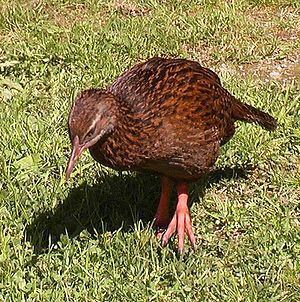Scientific name Gallirallus Higher classification Rallidae | Family Rallidae Phylum Chordata Rank Genus | |
 | ||
Lower classifications | ||
Flora carpark weka mt arthur native birds gallirallus australis
Gallirallus is a genus that contains about a dozen living, and several recently extinct, species of rails that live in the Australasian-Pacific region. The genus is characterised by an ability to colonise relatively small and isolated islands and thereafter to evolve flightless forms, many of which became extinct following Polynesian settlement.
Contents
- Flora carpark weka mt arthur native birds gallirallus australis
- Buff banded rail gallirallus philippensis
- Description
- Living and recently extinct species
- Species extinct before 1500 AD
- References
Buff banded rail gallirallus philippensis
Description
Many of the rails, including the well-known weka of New Zealand, are flightless or nearly so; others, such as the buff-banded rail, can travel for considerable distances once airborne even though they are not great flyers. This has enabled the flying species of this genus to colonize islands all over the region.
Many of the resultant flightless island endemics became extinct after the arrival of humans, which hunted these birds for food, introduced novel predators like rats, dogs or pigs, and upset the local ecosystems. A common Polynesian name of these rails, mainly relatives of G. philippensis, is veka/weka (in English, this name is generally limited to Gallirallus australis).
One species, the Guam rail, is extinct in the wild; there exists a semi-wild population in preparation for reintroduction to its original habitat. Three more species have gone extinct in historic times, while the New Caledonian rail probably is extinct. The Sharpe's rail, only known from the type specimen of unclear origin, may also be extinct, although recent evidence suggests that it is invalid, and instead should be regarded as a morph of the buff-banded rail. Two further species are assumed from circumstantial evidence to have survived into the Modern era but are not known from recent specimens.
On the other hand, Gallirallus species are (with the exception of the weka) notoriously retiring and shy birds with often drab coloration. Given that the Okinawa rail and the Calayan rail have only been discovered in the late 20th century and as late as 2004, respectively, it cannot be ruled out that the New Caledonian and Sharpe's rail may still exist.
Living and recently extinct species
These species are placed by BirdLife International and IUCN in separate genus Hypotaenidia
